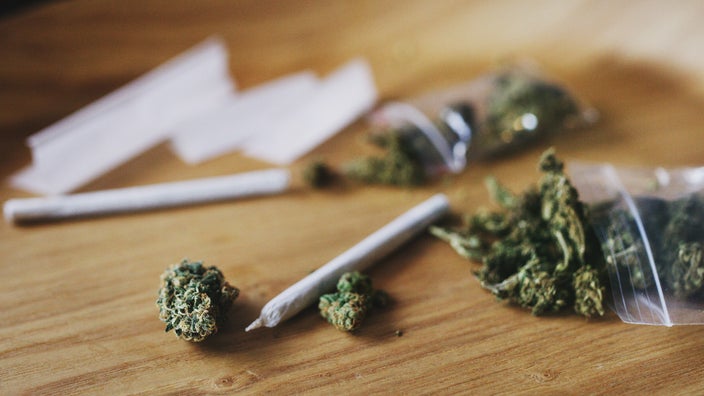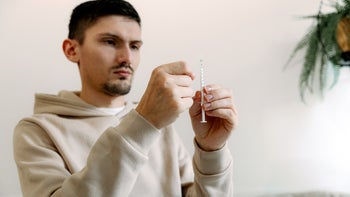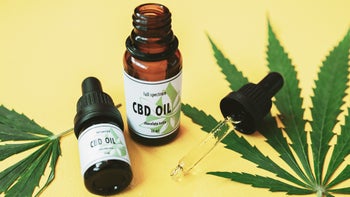
Can You Overdose on Weed? Yes, But It’s More Likely With Edibles
Key takeaways:
An overdose happens when you take too much of a medication or substance. You can overdose on cannabis (weed). But an overdose is rarely fatal.
Edibles tend to cause more cannabis overdoses because of the lag in their effect as well as how the body processes them.
Limiting your THC intake, taking regular breaks, and using regulated products can make an overdose less likely.
Table of contents

As a new — or even experienced — cannabis user, you might be concerned about how much is safe to take. What happens if you take too much? Can you overdose on weed the way you can with opioids or other illicit drugs?
Here, we’ll cover what happens if you overdose on weed, why it’s more likely to happen with edibles, and how to avoid an overdose in the first place.
Can you overdose on THC from weed or edibles?
Yes, tetrahydrocannabinol (THC), an active ingredient in cannabis, is no different than any other medication. So it’s possible to overdose on THC, or to take more than recommended. An overdose can happen by accident or it can be intentional. It can also be mild or severe.
Search and compare options
What’s tricky about cannabis is that there isn’t a set amount of THC that causes an overdose. The amount of THC your body can handle is different for everyone. It depends on your own endocannabinoid system (ECS) as well as how often you consume cannabis and what type of product you’re taking. And it can change based on your mental state and the setting you consume it in. A cannabis dose that was fine one time can lead to overdose symptoms another time.
Can a THC overdose kill you?
It’s common to wonder if too much weed can kill you. In most cases, a cannabis overdose is unlikely to be fatal on its own. But cannabis has played a role in deaths from heart complications, especially when it’s combined with other substances.
Keep in mind that just because a cannabis overdose isn’t typically life-threatening doesn't mean there’s no risk involved. In some cases, too much THC can lead to a psychotic reaction that requires medical care. And sometimes, these symptoms continue even after the cannabis has worn off.
Why are cannabis overdoses more common with edibles?
Cannabis overdoses are more common with edibles for a variety of reasons.
1. Edibles take a long time to start working
Many cannabis overdoses happen because people eat an edible and don’t wait long enough to feel its effects. So they take another dose, thinking they need more. And it's only after both doses eventually kick in that they realize they’ve taken too much.
Inhaled THC starts working within minutes and usually wears off after 2 to 3 hours. But edible THC can take anywhere from 30 minutes to 2 hours to kick in. In fact, it may take up to 4 hours to feel the full effects of some edibles. The effects of cannabis edibles also last longer — up to 12 hours.
THC Dosage Guide: Learn how to dose THC safely and how dosage forms differ in their effects.
Cannabis side effects: Review common and rare cannabis side effects and how to manage them if they occur.
Medical versus recreational weed: What’s the difference between them, and which is better?
The reason for this difference is due to how cannabis is absorbed. When you inhale it, the active ingredients are absorbed through your lungs directly into your bloodstream, then to your brain. When you eat cannabis, it has to go through your digestive system and get processed by your liver before it enters your bloodstream and reaches your brain, which takes longer.
2. Edible are processed differently by the body
There’s also a difference in how you’ll feel based on how you consume cannabis. Even if an inhaled cannabis product and an edible cannabis product contain the same amount of THC, the edible can still cause a stronger high. That’s because when you eat or drink THC, your liver processes it into a molecule called 11-hydroxy THC. This form of THC is stronger and more intoxicating when it reaches your brain.
3. Accurate dosing is harder with some edibles
It can also be harder to know how much cannabis an edible contains — especially if it’s homemade. Even commercial cannabis edibles can be misleading with their packaging, making it hard to know what a serving size is and how much THC is in each serving. For instance, if you eat an entire chocolate bar thinking it’s 10 mg of THC, but it was actually 10 mg of THC per square of chocolate, an overdose can happen.
Read more like this
Explore these related articles, suggested for readers like you.
4. Children often mistake cannabis edibles for food
Edible overdoses are also often reported in children. It’s easy for kids to accidentally consume cannabis edibles by mistaking them for regular food or candy items. This is why it’s important to store cannabis edibles safely and away from other food items.
How to know if you’ve taken too much THC
Even though edibles have a greater risk of overdose, you can take too much THC regardless of how you consume it. And you likely won’t know you’ve overdosed until symptoms appear.
THC can often cause the following effects at typical doses:
A sense of relaxation
A “high” or euphoric feeling
Increased heart rate
Increased appetite
Red eyes
Distorted sense of time
Poor coordination
Difficulty with memory
Trouble thinking clearly
Some people might enjoy these effects, and some might not. For example, if you struggle with social anxiety, the relaxed and euphoric feelings from THC might make it easier to talk to others. But if you’re treating arthritis pain, poor coordination and trouble thinking clearly could make it harder for you to perform your usual daily tasks. For these symptoms, what counts as an “overdose” of THC can depend on how a person wants to feel — contrary to popular belief, it’s possible to use cannabis without feeling high.
However, more serious side effects are possible for anyone who takes too much THC, regardless of their intended use. These include:
Anxiety
Panic attacks
Paranoia
Chest pain
Nausea and vomiting
Seeing or hearing things that aren’t really there
Feeling as if you are not yourself or that you might die
Seizures
What can you do if you take too much THC?
Unfortunately, there’s no way to reverse a cannabis overdose. The effects have to wear off with time. But you can make the experience more tolerable by practicing relaxation techniques, finding safe distractions, or taking a nap.
When to get medical attention
It’s best to seek medical care if your symptoms are worsening or won’t go away after consuming cannabis. Sometimes, the anxiety caused by THC may cause you to overreact, but it’s always better to be safe than sorry. Seek emergency care if you’re having chest pain, trouble breathing, or vomiting that won’t stop. You should also get professional help if you or someone you know develops aggression, confusion, or extreme anxiety from an overdose.
If a child consumes cannabis that wasn’t prescribed for them, it’s best to call Poison Control at 1-800-222-1222 or seek emergency care. Children can be more sensitive to the negative effects of THC, so it’s best to get them medical care as soon as possible.
Tips for how to prevent a THC overdose
When it comes to consuming THC, there are several tips that can help reduce your chance of an overdose.
Pay attention to dosing
For many people, the best approach is to start with a low dose and add more if you need it. But be sure to wait long enough for the first dose to kick in before you decide if you need more.
There aren’t approved dosages for THC, because it’s still considered an illegal substance at the federal level. In research settings, the standard unit of THC is 5 mg. But experts recommend starting with half that dose (2.5 mg) and slowly increasing it as needed up to a maximum of 40 mg of THC per day.
If you’re new to cannabis, consider a high-CBD product or one that contains an equal amount of CBD and THC. These products aren’t as likely to cause an overdose.
Good to know: If you’re thinking about incorporating cannabis into your wellness routine, it’s always best to check in with a healthcare professional first. They can help you understand the risks and benefits of using cannabis, including how it might interact with any other medications you’re taking.
Purchase regulated products
Cannabis products sold at state-regulated dispensaries are more likely to have accurate labeling and dosing instructions. They’re also less likely to contain contaminants, such as heavy metals or other substances, that could contribute to unwanted effects or an overdose.
Take regular breaks
You can build a tolerance to cannabis over time, which means you’ll need more and more THC to get the same results. But the more THC you consume, the more likely an overdose is. So it’s a good idea to take regular breaks of at least 48 hours (2 days) with no cannabis to help keep your tolerance low.
If you’re experiencing negative effects from THC, or overdose symptoms, It’s a good idea to stop using cannabis and speak to a healthcare professional.
Frequently asked questions
Cannabidiol (CBD) is generally considered safe, because it doesn’t have the same euphoric or heart-related effects as THC. Still, high doses of CBD can cause side effects, such as upset stomach, diarrhea, and drowsiness. Study participants have also developed liver problems after taking high doses of CBD over time. Keep in mind that although it’s considered safe, CBD products aren’t well regulated and can be improperly labeled. They may contain more CBD or THC than advertised or be contaminated with other chemicals — which can lead to a bad reaction.
Yes, you can eat the cannabis plant. In fact, people have consumed cannabis this way throughout history. But eating raw cannabis won’t have the same effect as a cannabis edible. That’s because the active components of cannabis, called cannabinoids, have to go through a process called decarboxylation before they’re active in the body. The easiest way to do this is by applying heat, which is why the cannabis plant is traditionally smoked. Now, cannabis oil is extracted from the plant and activated before it’s used to make edible products. We’re starting to learn that raw cannabis might have unique health benefits, but more research is needed.
The bottom line
Like any medication, it’s possible to take too much cannabis. But what’s considered a cannabis overdose may not be the same for everyone. That’s because we all respond to cannabis differently. In most cases, a cannabis overdose isn’t fatal. But serious side effects are possible. Keeping an eye on your THC intake can help prevent an overdose. Experts recommend starting with 2.5 mg of THC and slowly increasing your dose over time as needed.
Cannabis overdoses are more likely with edible products because they can take a long time to work and are processed differently in the body than other dosage forms. Edibles are also more likely to be involved in cannabis overdoses in children, since they’re easily mistaken for regular food.
Symptoms of a THC overdose can include anxiety, paranoia, and vomiting. Agitation, hallucinations, and heart-related problems are also possible. Seek medical care for any symptoms that seem life-threatening or that don’t improve with time. Otherwise, remain calm and try to find a safe, relaxing activity to distract you until the effects wear off.
Why trust our experts?



If you or someone you know struggles with substance use, help is available. Call SAMHSA’s National Helpline at 1-800-662-HELP (4357) to learn about resources in your area.
Keep in mind that cannabis is legal in some states for recreational and/or medicinal use, but not in others. Cannabis is still illegal under federal law. Before you use cannabis products, find out the laws in your state.
References
America’s Poison Centers. (n.d.). Cannabidiol (CBD).
Bhaskar, A., et al. (2021). Consensus recommendations on dosing and administration of medical cannabis to treat chronic pain: Results of a modified Delphi process. Journal of Cannabis Research.
Borke, J. (2023). Overdose. MedlinePlus.
Centers for Disease Control and Prevention. (2024). Cannabis and poisoning.
Crocq, M. (2020). History of cannabis and the endocannabinoid system. Dialogues in Clinical Neuroscience.
Egan, K. L., et al. (2024). Cannabinoid home storage practices among a national Qualtrics panel of adult users of cannabinoid products in the USA. Injury Prevention.
Filer, C. N. (2022). Acidic cannabinoid decarboxylation. Cannabis and Cannabinoid Research.
Government of Canada. (2021). Cannabis and your health.
Jameson, L. E., et al. (2022). Comparison of state-level regulations for cannabis contaminants and implications for public health. Environmental Health Perspectives.
Jeffers, A. M., et al. (2024). Association of cannabis use with cardiovascular outcomes among US adults. Journal of the American Heart Association.
National Institute on Drug Abuse. (2019). Cannabis (marijuana) DrugFacts.
Rock, E. M., et al (2021). Therapeutic potential of cannabidiol, cannabidiolic acid, and cannabidiolic acid methyl ester as treatments for nausea and vomiting. Cannabis and Cannabinoid Research.
Stella, B., et al. (2021). Cannabinoid formulations and delivery systems: Current and future options to treat pain. Drugs.
Urits, I., et al. (2020). Cannabis use and its association with psychological disorder. Pharmacology Bulletin.
Volkow, N. (2021). Establishing 5mg of THC as the standard unit for research. National Institute on Drug Abuse.
Keep in mind that cannabinoids are legal in some states for personal and/or medicinal use, but not in others. Certain cannabinoids are still illegal under federal law.





























